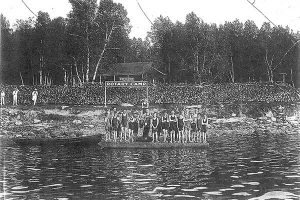Although the world is still immersed in 2020 and all that it has brought, we here at the Camp are planning for our hundred year celebrations. There are many wonderful plans in the making and we’ll let you know about them in the coming months.
We are busy gathering stories and photos from each decade and these will be posted on our website. These are fascinating with on persistent theme emerging – Camp Kawartha has been profoundly meaningful for those who were fortunate enough to attend. They say camp experiences are among their most memorable and enduring…

To give you a taste of what some former campers have been saying, here is an excerpt from a write up by Doug Cruthers who was a camper in the 1920s!
“It was 1927. The economy of Canada and Peterborough was still struggling to overcome the devastation of the First World War. Income levels were such that summer vacations for young boys away from their own homes were rare indeed.
Living in the area of the avenues south from Charlotte Street, there were many boys born during the war whose fathers worked at the C.G.E. Although the “Y” was over a mile away the activities there drew us like a magnet to swimming in the little pool (skinny of course), Leader Jimmy McNeeley, to the physical programs under Doug Loomis and the Hobby Show and craft activities all controlled by the dour Mr. Roper. But what to do during the summer months?
Eddie Huffman, Jack Cranfield, Ron Howe, the writer and countless others had the good fortune to attend the camp, usually for two weeks. What a wonderful camp it was!
There were many requirements – labels sewn into our clothes (made on cloth tape with indelible pencils), two blankets, two changes of underwear, two shirts, a sweater, two pairs of pants (cotton Kaki), a flash light if you had one (few did). I can’t remember night attire if any, a kit bag to hold it all. Tooth paste, soap, a towel, bathing suit, and 50 cents spending money for two weeks rounded off the list.
Virtually all supplies arrived by the pointer as did the boys. The “pointer” being a sturdy seaworthy flat-bottomed wood plank boat of some 18 feet over-all. The steamers Stoney Lake and Islinda plied the water and were a thrill to see and hear. The “pointer” had an outboard engine which provided reliable transportation.
Upon arrival at the camp four boys were assigned to a separate section of a bunk house which had two double bunks one over the other open at the roof peak. Each section was well equipped with a coal oil lantern and a bench. The first assignment was to fill one’s bed covers with clean new straw from a pile of straw at the back of the camp near the raspberry bushes. This project if well done (stuffed firmly into the cotton bag), resulted in good comfortable sleep at night. If not, the bare boards became pretty hard by morning as well as lumpy. Two boys to one mattress.”
Doug does go on from there and describes everything from the food, the activities to the privy! The campers today would not recognize much of this – imagine arriving at Camp by boat! But the difference camp made for him as a person shines through in his writing.


